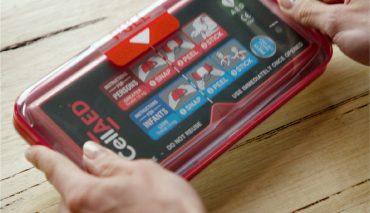Underpinning innovation with patents
As one of Rapid Response Revival’s innovation leaders, Head of Engineering Scott Finneran knows the importance of patent protection.
In this interview, Scott talks about what fuels invention, what motivates inventors to innovate, and why the work of reinventing defibrillation is so important.
Scott, what do patents mean to you?
“Rapid Response Revival is made up of really creative people. Patents underpin the ability of the business to be creative, and give us all the opportunity to create new ways to respond effectively to sudden cardiac arrest.
“They also give everyone involved in this business the assurance there is value in investing in innovation.
“Everyone has ideas. The really, really hard part is turning those ideas into something that is real, that delivers a real solution to an actual problem. Patents and other IP protections have given us the space we needed to achieve this.”
What do you use patents for?
“Patents ensure we have legal rights over the many improvements we’ve invented to tools used to help people survive sudden cardiac arrest.
“Our engineering teams are among the many disciplines involved in designing CellAED, which is a new type of AED (automated external defibrillator) and a huge improvement on what’s currently available.
“CellAED represents dozens of improvements on the status quo for AEDs. Some of these are obvious, others are more subtle – but each required many thousands of hours of research and development.
“Without patents, we wouldn’t have had the time and resources needed across the many disciplines of expertise needed to create this new type of medical device.”
Was it difficult to secure those protections?
“The bigger challenge has been convincing medical device regulators that CellAED isn’t a step too far.
“When it comes to innovation in medical devices, regulators are all about equivalents. They’re judging technological innovation on the standards of the equipment those innovations improve upon.
“This is understandable; a regulator needs to be sure the device will be effective, and do no harm. They reward manufacturers that play it safe. Change comes however, from those who don’t play it safe.
“We’ve had to embrace both sides. The regulations are there to ensure patient safety. But we know we can achieve that outcome without sacrificing innovation.”
Why do you need to innovate?
“Public access to defibrillation is not new. But AEDs haven’t fundamentally changed in decades.
“There are big problems with AEDs available today. They’re cumbersome, complicated and cost too much to build and buy, meaning they can’t be everywhere they’re needed.
“Making AEDs available to more people who need them, and especially to households, means improving on the AED design status quo.
“For example, take how AEDs are used. By significantly simplifying the way CellAED is deployed, we’ve overcome the barriers to use that prevent AEDs being used in an emergency. We couldn’t have achieved this with a pure equivalents approach.”
What barriers do you mean?
“People can struggle to understand and use technology at the best of times. This struggle is worse under pressure.
“My parents have difficulty getting their TV to talk to Netflix. I shudder to think how they’d cope with using a currently-available AED under pressure.”
“Innovation is the enabler that solves those user issues. It has made defibrillation accessible in the way that really matters: responding to an emergency.”
How has this been achieved?
“If you were to locate and pick up an AED now and open the case, chances are a bunch of leads would tumble out. You’ve got to unpack it, figure out where the leads plug in, turn the device on, untangle the leads, figure out where the pads go, and get your head around how to make the whole thing work. You’re meant to be able to do this in an emergency, under pressure.
“Currently-available AEDs were designed to be portable. They weren’t designed to be turnkey; ready to go when you switch them on.
“One way we improved on this design with CellAED was, we integrated the pads into the device. This made a massive difference.
“Of the huge number of registered complaints against AEDs, many boil down to the fact that the device hadn’t been maintained, and the batteries were flat.
“IoT functionality built into our device will address those problems. CellAED’s cellular connectivity will allow us to remotely monitor the health of the device.
“We also made it smaller and compact, designed to sit in a case on a wall, like a fire extinguisher. This improves on the current designs, which may be portable, but they’re still too bulky to keep in the open; they usually end up in a cupboard or cabinet, out of sight and out of mind.”
How did patents help to bring these improvements about?
“All this has taken years of development, by a team of very smart, experienced professionals who have worked on nothing else over that time.
“Patents have been one of the ways this business has been able to attract the investment required to make that happen. They’ve also given us the commercial runway to be able to fuel future innovation.
“The focus of this business is on getting AEDs into homes, which is where most sudden cardiac arrests occur. For this to happen, we need to keep innovating, to make AEDs even easier to use, and more accessible.
“Patents are also proof to the people who come first, our first customers, that this is a true innovation, that it works, and that it will save lives.”
RELATED ARTICLE: The importance of usability in medical device design
DISCLAIMER: CellAED is currently only approved for use in the member states of the . If you would like to be kept informed on when regulatory approval has been secured for your location, register your interest here.



